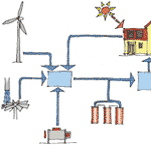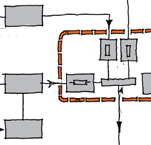Energy
Designing homes to conserve energy and use it efficiently, from sources that cause least environmental harm.
Stand-alone generation
A stand-alone power system is not connected to the grid power and relies solely on generating power on site. Power generated is stored in batteries.
On this page:
- Components and power sources
- Costs
- Converting DC to AC power

- Stand-alone system
Backup should be provided by batteries or a fossil fuel generator.
Find out:
- what stand-alone power generation systems are
- costs for stand-alone power generation
- about converting DC to AC power.
Components and power sources
The principal components of a stand-alone system are:
A back-up power source may also be included.
The power sources for stand-alone generation systems include:
- solar panels
- wind turbines
- micro-hydro
- micro-CHP (combined heat and power) units
- diesel or petrol generators
- a combination of any of the above.
Stand-alone energy system sizing
The correct sizing of stand-alone systems is critical to a successful outcome. The calculation must be completed in detail. The client’s current or expected power usage and habits must be analysed carefully to allow the calculation of a daily or weekly power consumption figure and a peak demand requirement. The size of generation, inverter/charger and batteries is calculated from that and must comply with AS/NZS 4509.1.
Costs for stand-alone power generation
Costs for grid connection and stand-alone systems vary considerably. Rural grid connections typically cost tens of thousands of dollars – $100,000 or more is possible in some situations. Stand-alone systems typically cost tens of thousands of dollars too, so the capital investment may be similar to a mains connection. But with a stand-alone system the owner controls the system, and ongoing costs may be lower.
Converting DC to AC power
A stand-alone system typically generates power as direct current (DC) supply whereas most appliances require an alternating current (AC) power supply.
DC power may be reticulated to lights and small DC-powered appliances as a means of providing a cost-effective and energy-efficient supply to a small demand system (12 or 24 volts) such as to a remote hut, caravan or house bus.
Most households require AC reticulation as AC is at a higher voltage and appliances are generally designed to use AC current. An inverter converts the DC power generated and stored in the batteries to AC power (normal grid power) for reticulation around the house.
More information
- www.genless.govt.nz – solar panels
Updated: 21 September 2020


